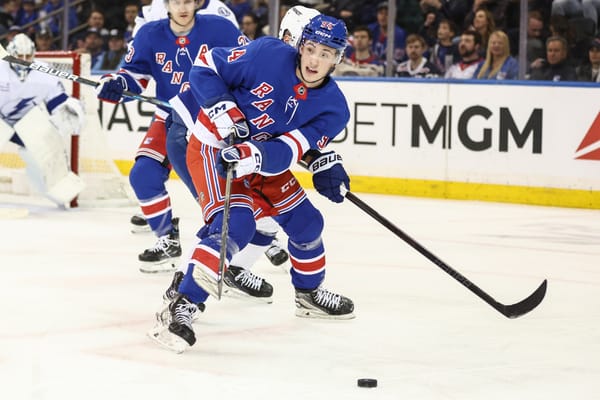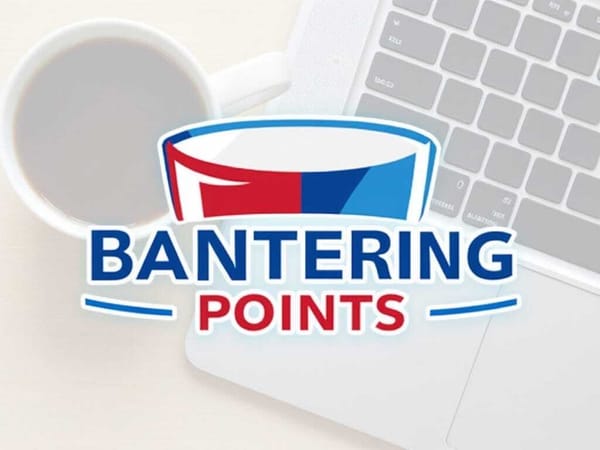The Rangers Have a Tony DeAngelo Problem
Tony DeAngelo represents a lot of things.
He represents a top-flight NHL defensive prospect, with an offensive ceiling that was worthy of shock and awe when he was traded from the Tampa Bay Lightning to the Arizona Coyotes back in 2016. He’s a guy who had 89 points in the final 55 OHL games of his career, and has since compiled 72 points in 123 AHL games. Of all the “borderline” defensemen that the Rangers have in the NHL or in Hartford right now, DeAngelo has the highest offensive ceiling and it isn’t even close. The question isn’t the talent with DeAngelo, the question is whether or not he has the ability to still see it through. Whether or not he still has time. Or, even, enough chances left.
DeAngelo also represents something more complicated. In the past he’s been very public about his conservative political orientations, going so far as to shout out key victories during Donald Trump’s election bid on his Twitter feed. Most recently he even debated the conservative values he believes in on Twitter by making a claim that he didn’t want to pay more taxes as a defense of his beliefs. In a more liberal city like New York, that understandably rubbed a lot of people the wrong way. That DeAngelo is conservative isn’t really surprising. There are a lot of conservative young men from affluent families in the NHL, but most are wise enough to keep their political leanings off of social media. This all wouldn’t be as noticeable if DeAngelo didn’t have a past of using racial and/or homophobic slurs in juniors (although it’s vital to note that there have been none that we know of since).
It’s more than just the political ideologies that complicate DeAngelo. He has received discipline on two occasions for abusing officials, one of which came at the NHL level. He’s been followed by red flags in every league he’s played in, something Adam did a good job wrapping up in his 2017 Blueshirt Banter Prospect Rankings:
A few incidents became widespread news because of severity and circumstance. DeAngelo was suspended in the OHL for abuse of an official in 2014, and then again this past season in the NHL for the same thing. Also in 2014, he was suspended for eight games for directing bigoted remarks towards his own teammate. There seems to be this spreading notion that DeAngelo is being smeared for a few teenage incidents in the heat of the moment; kids will be kids. These instances are tremendous red flags even when viewed in isolation. Even still, the problems with DeAngelo run way deeper than these three particular incidents.
There is plenty more that hasn’t reached the mainstream. I spoke to a well-connected OHL employee, and he remarked that coaches across the league went through a “daily struggle” dealing with DeAngelo; the words “gong show” were used. The way it was described to me, DeAngelo is fine when things are going well. He’s highly competitive, and so when the team is winning, he’s at his best. Otherwise, he’s a ticking time bomb.
But here’s the thing: the Rangers knew all of that, because it all happened before they targeted him. It didn’t stop Jeff Gorton from acquiring him in the Derek Stepan trade, so none of this should have been a surprise when he came around. At the time of the trade, the Rangers obviously believed he was worth the risk. It also means the organization was more interested in his talent before they traded for him than they were after they got him; since they haven’t really given him a shot to succeed or fail since he came to Broadway.
People can try to tell you DeAngelo wasn’t a vital part of the Stepan trade, but that’s a flat-out lie at worst, or, at best, it’s a misunderstanding of the deal. Per a source at the time, the Rangers were desperately trying to pry Clayton Keller from Arizona when they were negotiating the Stepan deal. When that didn’t happen they settled on the DeAngelo and 7th overall package, where Jeff Gorton saw DeAngelo as a player who brought a critical element to the organization that had been missing.
Note: The Rangers, once they had 7th overall, tried to move up in the draft with Dallas to snag Cale Makar. When those negotiations fell through they prayed Elias Pettersson would fall to 7th. When that didn’t happen they took Lias Andersson. I tell you all this to make it clear DeAngelo was not some throwaway in that deal, since there was plenty of wishing that came along with the seventh overall pick. They had no idea they were taking Andersson until they hit the floor, since their real goal was to trade up for Makar and Plan B was Pettersson. This is not a knock on Andersson.
DeAngelo was brought in for a reason: his skill on the right side of the blue line, but he wasn’t given a chance to fill that role last year out of camp. A listless stint in Hartford didn’t help, nor did his ill-advised interactions with Rangers fans on Twitter, but DeAangelo eventually got called up nonetheless due to injuries and was playing solid hockey until he got hurt.
After the Rangers’ loss to Calgary Sunday night, David Quinn mentioned that DeAngelo “knows what he needs to do to get back in the lineup.” While that does mesh with Quinn’s no-nonsense approach to hard work and effort, it doesn’t really explain what the Rangers are planning to do with DeAngelo — or what their plan even was in the first place.
DeAngelo has been scratched for all but two of the team’s first eight games. On the surface this tells us that the team doesn’t think he’s ready for the NHL. And seeing how New York was sort of his last chance already, well you get the picture.
The thing is, the Rangers are still treating DeAngelo like precious cargo. Normally, DeAngelo would be sent down to Hartford until they thought he was ready for NHL action. The brass isn’t doing that right now because he’d have to pass through waivers to get to Hartford, and they know that isn’t likely to happen. So instead they’re keeping him with the big club, because they don’t want to lose him for nothing/value what he could bring to the table, but they’re also ... not playing him. A week ago Quinn talked about how Pionk wouldn’t sit for three games in a row, but then he turned around and gave DeAngelo that exact treatment. It appears that DeAngelo is somehow in a different category.
And if we’re only talking about hockey and what happens on the ice, it makes no sense.
At this point I don’t think anyone would blame the Rangers for admitting that the Stepan trade was a disaster and either cutting ties with DeAngelo via trade or taking the risk of sending him down and doing this again later. I’ve been vocal in my belief that DeAngelo deserves a shot to fail, but it looks like Quinn and Gorton think differently. Then again, maybe they do recognize his potential, because they seem loath to lose him for nothing on the waiver wire. Unfortunately, DeAngelo has no actual trade value at the moment. For free on an open market there are probably a dozen teams that would take a shot on him just to see what they might get, but no one is going to want him in a trade — not with his reputation and this being the third stop on a train to a non-NHL career.
The fear when the Stepan trade was completed was that the Rangers hadn’t done their homework on DeAngelo and were going to be stuck holding the business end of the risk they inherited. That’s pretty much what’s happened to this point, only they’ve done themselves no favors by not seeing what they have in the problematic defenseman in the first place. The only real shot at success here was the team unearthing the potential that exists in DeAngelo as they work through the issues. Both Alain Vigneault and now Quinn have found reasons to keep this kid out of the lineup, and while you can question Vigneault’s methods, Quinn has been more than consistent in his ideologies and decisions with players. That means DeAngelo is either dogging it at practice or simply isn’t doing enough to convince coaches he deserves a spot in a lineup this year with Adam McQuaid playing almost every night and Marc Staal actually playing every night. One way or another, it’s a bad look for Gorton.
Reclamation projections like that aren’t unheard of, and it made sense for the Rangers to take the risk, so long as they were going to see it through. They didn’t, and it appears the organization was fine with trading their top center and backup goalie for a seventh overall pick and then mostly washing their hands of DeAngelo.
The other question is where Gorton is in all this. The organization has watched players like Eric Staal and Keith Yandle get misused regardless of the price tag associated with acquiring them, so this isn’t new. The only thing to infer from the general manager’s continued silence on the matter is Gorton also doesn’t see an issue in DeAngelo’s lack of playing time but also doesn’t want to lose him for nothing. While I’m not advocating for Gorton to get involved in Quinn’s day-to-day business, it just continues to highlight the fact the Rangers should have never gotten DeAngelo in the first place since they weren’t ready to deal with the lumps. Heap as much blame on Vigneault and Quinn as you want for not using him, but the bigger issue here falls squarely on the general manager and only the general manager.
So now we’re here, with DeAngelo stuck in hockey purgatory and the organization holding the bag while dealing with an increasingly frustrating headache. DeAngelo has taken the situation in stride — not that he, in his current position, has another option — but it’s a position that helps neither the player nor the team. On talent alone, there’s no reason for him to not be in the lineup, and he knows it. DeAngelo very well may turn into a serviceable defenseman for another team if let go, and while I doubt he will ever hit his ceiling, it is still possible. After all, he is still only 22.
The Rangers simply aren’t handling this young defenseman the right way. They’re not showcasing him to potential suitors, or even to themselves. He sits in the press box, he practices as an extra, and soon he’ll get into the lineup only to start that cycle again. It’s been nearly 500 days since the Rangers acquired DeAngelo and he has still played more games as an Arizona Coyote than he has as a Ranger.
There’s probably more to this story that we don’t know, but one thing is clear: the Rangers either screwed up on the day they traded for him and/or they’ve done nothing but screw up since they acquired him.





